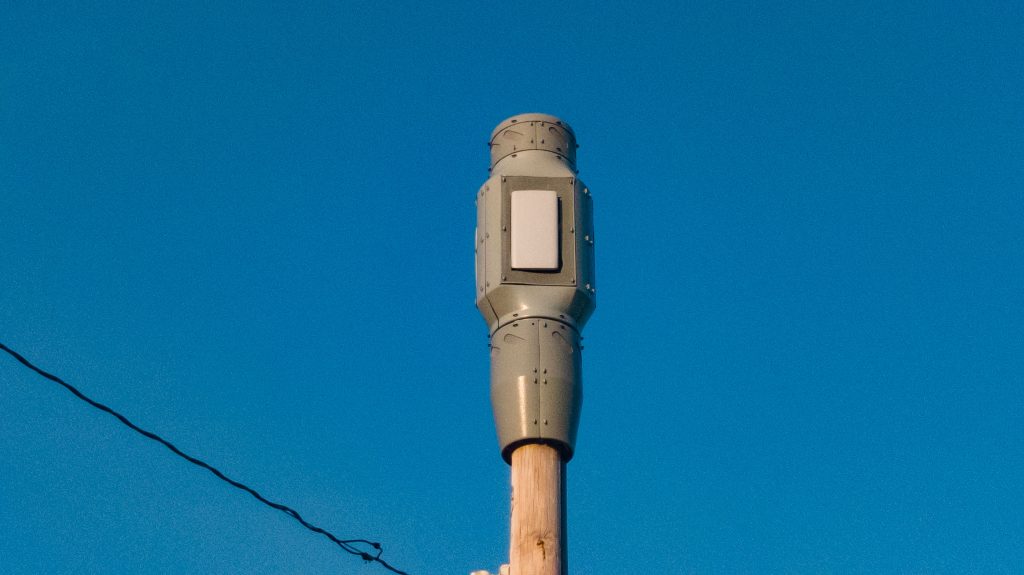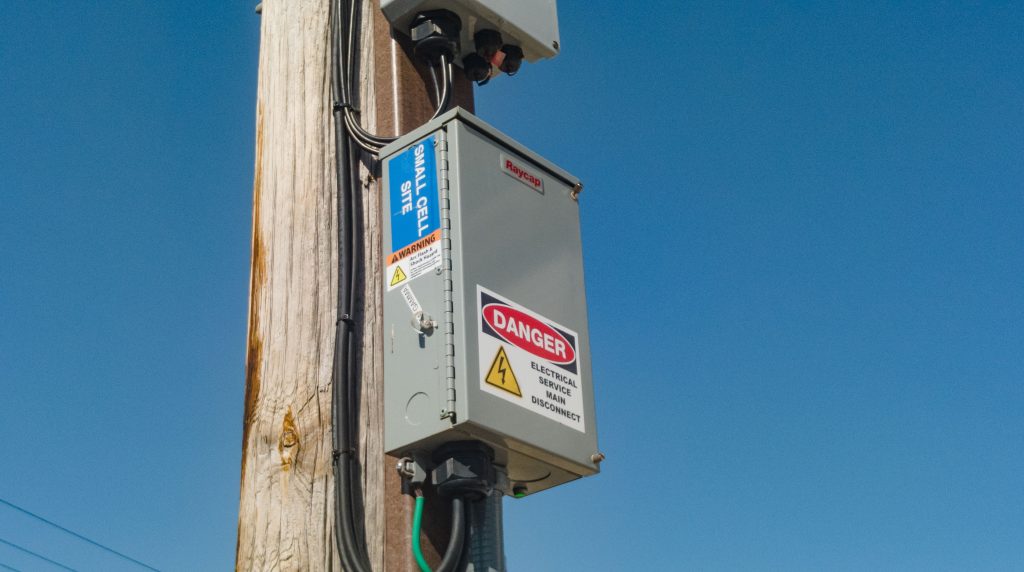
A small 5G wireless facility on top of an existing timber pole, Lavallette, N.J., May 2023. (Photo: Shorebeat)
Seaside Park’s planning board has recommended approval for a plan proposed by Verizon to place several “small cell” nodes, capable of expanding bandwidth and improving network speed, in the borough, but stopped short of endorsing the entirety of the wireless provider’s plan.
The board, last week, adopted a resolution detailing a decision made at its previous meeting that covers the siting of poles, cabinets and antennas – colloquially known as a “small cell” network – at various locations in the borough. The idea behind such a network, Verizon representatives have said, is to have a mesh network of antennas – essentially, smaller and more aesthetically pleasing versions of the large nodes often found on top of large poles and water towers – on top of poles that are about the same height as a normal utility pole. These nodes, as they are known, provide high-speed mobile data service on a variety of frequencies, can support 5G speeds, and free up network capacity, which notoriously becomes jammed at the height of the summer season.
Verizon had initially proposed locating the nodes adjacent to 74 O Street and 13 J Street, and two more at 117 N Street and 67 Stockton Avenue. The second two proposed locations were rescinded by Verizon, and the board recommended that the borough council approve permits for the O Street location to be deployed.
Objections were raised by some residents and board members with regard to the J Street location, however, due to its proximity to a driveway apron that could have become a hazard to motorists. Verizon’s representatives at the meeting “agreed to meet with the board engineer and explore relocation of the J Street pole to a location on the easterly side of Ocean Avenue where it intersects with J Street,” the board attorney wrote in the ensuing resolution.
Ultimately, the agreed-upon location for the oceanside antenna was to be 919 North Ocean Avenue, indeed on the easterly side of the intersection of J Street and Ocean.
Local planning boards and city councils are limited in the regulatory authority they wield over the deployment of wireless infrastructure. Many of the land use aspects of the matter are codified by the Federal Communications Commission, largely in order to avoid “not in my backyard” issues preventing the nation’s wireless coverage from keeping up with technology. Federal guidelines do, however, allow some level of regulation by way of allowing municipalities to set up a permitting process and reasonable conditions.
Seaside Park’s recommendation from the board included a few conditions, including requiring Verizon to utilize a third-party contractor to perform an emissions test from each location within 60 days of it being put into service, and another test annually of each antenna during a period of peak demand in July. The board also conditioned its endorsement on Verizon’s ability to all “demonstrate future co-location” ability for each tower – essentially, allowing other providers to utilize the same pole in order to avoid a scenario in which every wireless provider proposes its own poles in town.
The poles would be restricted to 35-feet in height, or 110 percent of adjacent utility poles, whichever is higher. The poles would have to be placed within 18-inches of the curb, even if a current pole is replaced. The company was also mandated to ensure its antennas would not interfere with any emergency communications or marine GPS service. Verizon, for its part, has said the deployment of small cell networks increases public safety capability since police will have more reliable and faster access to data within their vehicles.
The so-called “cabinets” that manage the poles through software and connections are preferred to be located underground rather than on the pole itself, if possible. If the cabinets are to be located above-ground, Verizon will be required to notify the borough as to why it could not be located underneath.

A small 5G wireless ‘cabinet’ attached to an existing timber pole, Lavallette, N.J., May 2023. (Photo: Shorebeat)
The recommendation of the planning board, now that it has been adopted, will go to the borough council so the governing body can act on Verizon’s permit. Federal regulations require a 60-day “shot clock” for permits to be approved once submitted and cleared by city professionals or an advisory body – in this case, the planning board.

Advertisement

Seaside Heights & Seaside Park
Seaside Heights School Board Seeking More Participation, Will Change Meeting Times

Police, Fire & Courts
Seaside Park Man, 68, Charged in Fatal Crash With Pedestrian

Ortley Beach & North Beaches
Lottery Ticket Worth $10K Sold at Ortley Beach Acme

Ortley Beach & North Beaches
Abandoned Private Island ‘Mansion’ in Barnegat Bay Poised for Demolition







